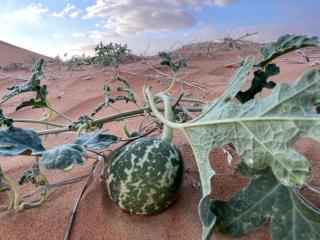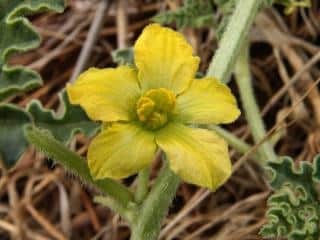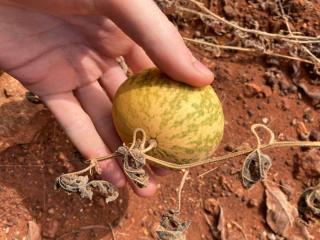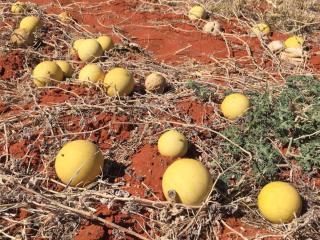

Colocynth is a surprising “herb vegetable”. Only seeds are edible, though.
Key Colocynth facts
Name – Citrullus colocynthis
Family – Cucurbitaceae gourd family
Type – herb vegetable
Height – 8 to 20 inches (20 to 50 cm)
Exposure – full sun
Soil: rich and well drained (sandy is ideal) – Harvest: fall
Fruits are round and striped, the size of your fist. The flesh of the fruit has many medicinal properties.
→ It’s a relative of another rare but useful fruit: Citron melon.
Grow colocynth just as you would watermelon, they both come from the same family.
 As an annual, start sowing in March in a sheltered spot and then transplant to the growing bed in May. Another option is sowing in place directly in May.
As an annual, start sowing in March in a sheltered spot and then transplant to the growing bed in May. Another option is sowing in place directly in May.
When transplanting seedlings or sowing seeds directly, give each plant 3 feet (1 meter) growing space to all sides. Colocynth needs enough room to spread.
 Pinch off stems after the 3rd or 4th leaf to stimulate plant growth.
Pinch off stems after the 3rd or 4th leaf to stimulate plant growth.
Keep colocynth fruits from staying in close contact with the soil. This could lead it to rot, so it is better to add a slab of wood, mulch or plastic between fruit and ground.
 Unlike pumpkins for which keeping and ripeness are important, the harvest period of colocynths is much earlier. The younger the fruit, the more potent its medicinal effects.
Unlike pumpkins for which keeping and ripeness are important, the harvest period of colocynths is much earlier. The younger the fruit, the more potent its medicinal effects.
 Colocynth is grown in desert regions of the Middle East and Northern Africa for its medicinal properties. Fruits are extremely bitter and a power laxative, to be used only with caution.
Colocynth is grown in desert regions of the Middle East and Northern Africa for its medicinal properties. Fruits are extremely bitter and a power laxative, to be used only with caution.
Colocynth seeds, however, are edible and have a high oil content. They’re not toxic in any manner. Some African cultures roast the seeds and eat them whole.
Take care not to let too many fruits develop on a single plant (at most 5 or 6).
Having too many fruits might reduce the quality of the entire harvest overall.